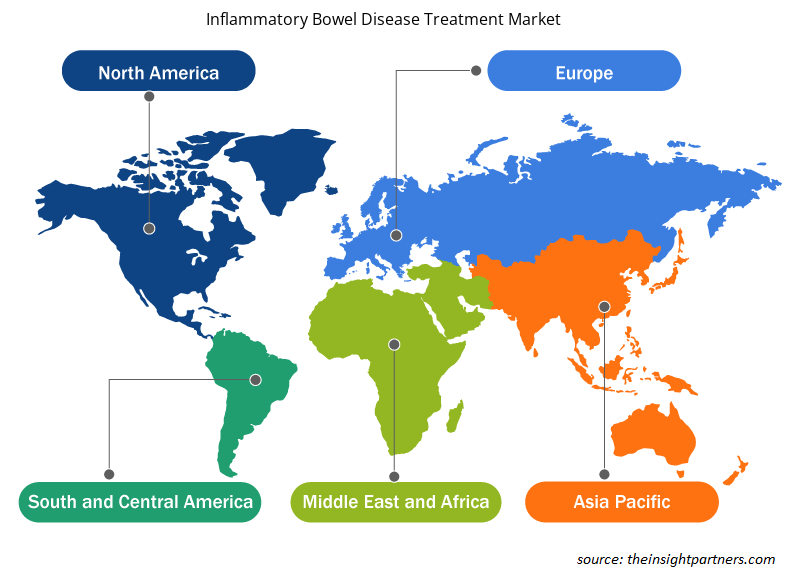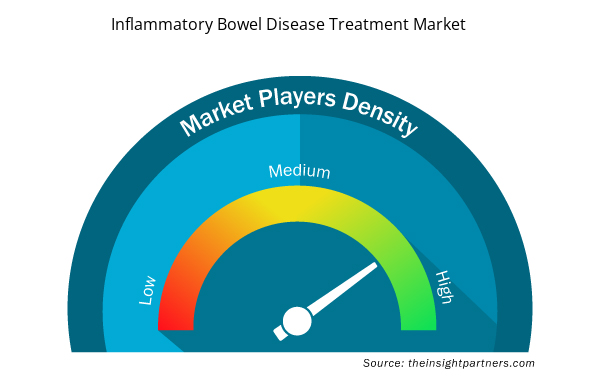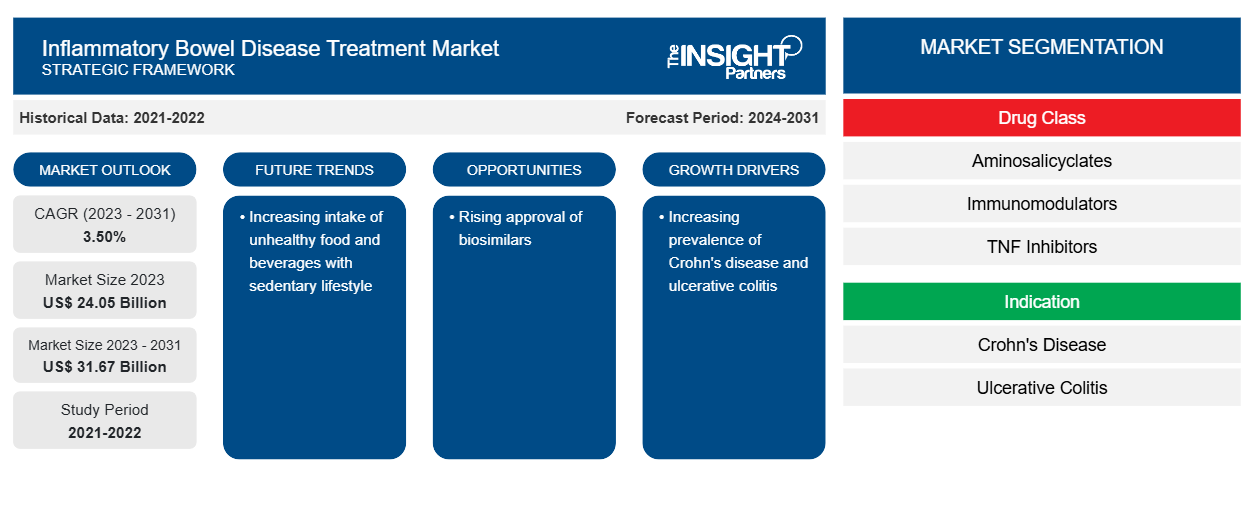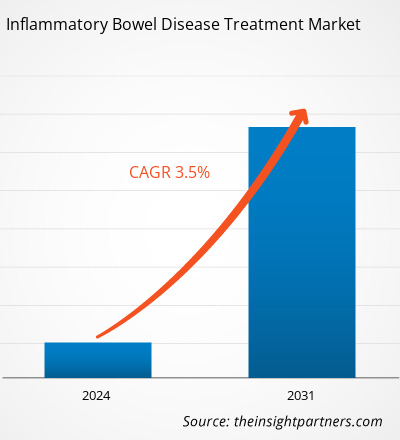炎症性肠病治疗市场价值预计将从 2023 年的 240.5 亿美元增长到 2031 年的 316.7 亿美元;预计 2023 年至 2031 年期间市场复合年增长率为 3.50%。CAGR of 3.50% from 2023 to 2031.
市场洞察和分析师观点:
炎症性肠病 (IBD) 是一种慢性胃肠道炎症疾病,包括克罗恩病和溃疡性结肠炎。这些疾病会导致消化道内壁发炎,从而导致腹痛、腹泻、疲劳和体重减轻等症状。治疗旨在通过药物、改变生活方式以及有时进行手术来减少炎症、控制症状和预防并发症。治疗 IBD 通常需要持续的医疗护理和监测,以维持缓解并改善生活质量。推动炎症性肠病治疗市场增长的关键因素是克罗恩病和溃疡性结肠炎患病率的上升以及产品推出数量的增加。本报告包括当前炎症性肠病治疗市场趋势及其在预测期内可预见的影响带来的增长前景。技术进步可能会在未来几年为炎症性肠病治疗市场带来重大趋势。此外,通过持续研究开发创新治疗方法以及鼓励政府举措也有望推动市场增长。
增长动力和挑战:
克罗恩病是一种复杂的慢性疾病,主要影响消化系统。美国国家医学图书馆指出,2023 年每 100,000 人中有 825 例 IBD,其中克罗恩病有 410 例,溃疡性结肠炎和 IBD-u 有 414 例。2023 年,322,600 名加拿大人患有 IBD,患病率为 0.82%。由于诊断测试的禁食要求、治疗性饮食限制以及厌食症导致的食欲不振或疾病本身导致的营养需求改变,患有胃肠道疾病的患者营养恶化的风险增加。因此,肠内营养适用于胃肠道疾病患者,因为肠内途径是提供所需营养的首选。因此,克罗恩病和溃疡性结肠炎患病率的上升推动了炎症性肠病治疗市场的增长。
克罗恩病、创伤引起的胃肠道疾病、肠梗阻 (BO)、显微镜结肠炎、短肠综合征和溃疡性结肠炎是几种常见的胃肠道疾病。根据 2021 年 Healthline 发表的一篇文章,全球约 40% 的人患有功能性胃肠道疾病。加拿大消化健康基金会表示,数百万加拿大人患有消化系统疾病;每年约有 2000 万加拿大人,即每 3 人中就有 2 人患有消化系统疾病。
另一方面,治疗炎症性肠病 (IBD) 的高成本是 IBD 治疗市场面临的一个重大障碍。从昂贵的药物到频繁的住院和手术,治疗 IBD 会给患者和医疗保健系统带来沉重的经济负担。成本因素通常会限制许多 IBD 患者获得最佳护理和创新治疗的机会。解决负担能力和可及性问题对于改善受这种慢性病影响的患者的治疗结果和生活质量至关重要。因此,治疗的高成本阻碍了炎症性肠病治疗市场的增长。
定制此报告以满足您的需求
您可以免费定制任何报告,包括本报告的部分内容、国家级分析、Excel 数据包,以及为初创企业和大学提供优惠和折扣
- 获取此报告的关键市场趋势。这个免费样品将包括数据分析,从市场趋势到估计和预测。
报告细分和范围:
炎症性肠病治疗市场分析考虑了以下几个部分:药物类别、疾病适应症和分销渠道。根据地域,炎症性肠病治疗市场分为北美(美国、加拿大和墨西哥)、欧洲(英国、德国、法国、意大利、西班牙和欧洲其他地区)、亚太地区(中国、日本、印度、澳大利亚、韩国和亚太其他地区)、中东和非洲(阿联酋、沙特阿拉伯、南非和中东和非洲其他地区)以及南美洲和中美洲(巴西、阿根廷和南美洲和中美洲其他地区)。
节段分析:
基于药物类别的见解
根据药物类别,市场细分为生物制剂、氨基水杨酸盐、皮质类固醇等。生物制剂领域在 2023 年占据了炎症性肠病治疗市场的最大份额,预计在 2023-2031 年期间将实现最高复合年增长率。
基于疾病指征的见解
根据疾病适应症,炎症性肠病治疗市场分为克罗恩病和溃疡性结肠炎。预计到 2031 年,克罗恩病领域将占据相当大的市场份额。
基于疾病指征的见解
根据分销渠道,市场分为医院药房、零售药房和网上药房。预计到 2031 年,医院药房部门将占据炎症性肠病治疗市场的重要份额。
炎症性肠病治疗市场区域洞察
Insight Partners 的分析师已详细解释了预测期内影响炎症性肠病治疗市场的区域趋势和因素。本节还讨论了北美、欧洲、亚太地区、中东和非洲以及南美和中美洲的炎症性肠病治疗市场细分和地理位置。

- 获取炎症性肠病治疗市场的区域特定数据
炎症性肠病治疗市场报告范围
| 报告属性 | 细节 |
|---|---|
| 2023 年的市场规模 | 240.5亿美元 |
| 2031 年市场规模 | 316.7亿美元 |
| 全球复合年增长率(2023 - 2031) | 3.50% |
| 史料 | 2021-2022 |
| 预测期 | 2024-2031 |
| 涵盖的领域 | 按药物类别
|
| 覆盖地区和国家 | 北美
|
| 市场领导者和主要公司简介 |
|
炎症性肠病治疗市场参与者密度:了解其对业务动态的影响
炎症性肠病治疗市场正在快速增长,这得益于终端用户需求的不断增长,而这些需求又源于消费者偏好的不断变化、技术进步以及对产品益处的认识不断提高等因素。随着需求的增加,企业正在扩大其产品范围,进行创新以满足消费者的需求,并利用新兴趋势,从而进一步推动市场增长。
市场参与者密度是指在特定市场或行业内运营的企业或公司的分布情况。它表明在给定市场空间中,相对于其规模或总市场价值,有多少竞争对手(市场参与者)存在。
在炎症性肠病治疗市场运营的主要公司有:
- 辉瑞公司
- 诺华公司,
- AbbVie 公司
- 武田制药、强生
- 、Celegene 公司、
- 博士伦医疗公司
免责声明:上面列出的公司没有按照任何特定顺序排列。

- 了解炎症性肠病治疗市场顶级关键参与者概况
区域分析:
炎症性肠病治疗市场报告的地理范围包括北美、欧洲、亚太地区、中东和非洲以及南美和中美洲。2023 年,北美占据了最大的市场份额。美国以最大的收入份额在北美市场占据主导地位。该国炎症性肠病治疗市场规模的扩大归因于炎症性疾病患病率的上升、主要市场参与者的存在及其战略举措。支付解决方案的改进、高治疗率、创新药物处方的增加、不间断的研究努力和有利的政府举措也使美国和其他北美国家的炎症性肠病治疗市场受益。克罗恩病和结肠炎基金会是值得注意的组织之一,致力于促进旨在治疗结肠炎和克罗恩病的临床和转化研究。
竞争格局和重点公司:
本报告中提出的炎症性肠病治疗市场预测可以帮助该市场的利益相关者制定增长战略。AbbVie Inc、武田制药有限公司、辉瑞公司、百健、诺华公司、礼来、UCB SA、CELLTRION INC.、默克公司和强生服务公司是炎症性肠病治疗市场报告中介绍的几家主要公司。这些公司专注于扩大其产品范围,以满足全球不断增长的消费者需求。他们的全球业务使他们能够为许多客户提供服务,从而扩大其市场占有率。
- 历史分析(2 年)、基准年、预测(7 年)及复合年增长率
- PEST 和 SWOT 分析
- 市场规模价值/数量 - 全球、区域、国家
- 行业和竞争格局
- Excel 数据集


- Airline Ancillary Services Market
- Broth Market
- Sterilization Services Market
- Machine Condition Monitoring Market
- Hand Sanitizer Market
- Medical Audiometer Devices Market
- Rugged Servers Market
- Electronic Shelf Label Market
- Retinal Imaging Devices Market
- Advanced Planning and Scheduling Software Market

Report Coverage
Revenue forecast, Company Analysis, Industry landscape, Growth factors, and Trends

Segment Covered
This text is related
to segments covered.

Regional Scope
North America, Europe, Asia Pacific, Middle East & Africa, South & Central America

Country Scope
This text is related
to country scope.
常见问题
Based on drug class, the market is segmented into biologics, aminosalicyclates, corticosteroids, and others. The biologics segment held the largest Inflammatory Bowel Disease Treatment Market share in 2023 and is anticipated to register the highest CAGR during 2023–2031.
Based on disease indication, the Inflammatory Bowel Disease Treatment Market is segmented into crohn's disease and ulcerative colitis. The crohn's disease segment is anticipated to hold a significant share by 2031.
The Inflammatory Bowel Disease Treatment Market was valued at US$ 24.05 billion in 2023.
The Inflammatory Bowel Disease Treatment Market is expected to be valued at US$ 31.67 billion in 2031.
The Inflammatory Bowel Disease Treatment Market has major market players, including AbbVie Inc, Takeda Pharmaceutical Company Limited, Pfizer Inc, Biogen, Novartis AG, Lilly, UCB S.A., CELLTRION INC., Merck & Co., Inc., and Johnson & Johnson Services, Inc.
The key factors driving the Inflammatory Bowel Disease Treatment Market growth are the rising prevalence of crohn's disease and ulcerative colitis and increasing product launches over the projection period. Inflammatory Bowel Disease Treatment Market trends include the technological advancement in IBD treatment. Furthermore, the development of innovative treatments through continuing research as well as encouraging government initiatives are also expected to fuel the market growth.
Inflammatory bowel disease" (IBD) is a chronic inflammatory condition of the gastrointestinal tract, including Crohn's disease and ulcerative colitis. These conditions cause inflammation of the digestive tract lining, leading to symptoms like abdominal pain, diarrhea, fatigue, and weight loss. Treatment aims to reduce inflammation, manage symptoms, and prevent complications through medication, lifestyle changes, and sometimes surgery. Managing IBD typically requires ongoing medical care and monitoring to maintain remission and improve quality of life.
Trends and growth analysis reports related to Life Sciences : READ MORE..
The List of Companies - Inflammatory Bowel Disease Treatment Market
- AbbVie Inc
- Takeda Pharmaceutical Company Limited
- Pfizer Inc
- Biogen
- Novartis AG
- Lilly
- UCB S.A.
- CELLTRION INC.
- Merck & Co., Inc.
- Johnson & Johnson Services, Inc.
- Mindray Medical International Limited
The Insight Partners performs research in 4 major stages: Data Collection & Secondary Research, Primary Research, Data Analysis and Data Triangulation & Final Review.
- Data Collection and Secondary Research:
As a market research and consulting firm operating from a decade, we have published and advised several client across the globe. First step for any study will start with an assessment of currently available data and insights from existing reports. Further, historical and current market information is collected from Investor Presentations, Annual Reports, SEC Filings, etc., and other information related to company’s performance and market positioning are gathered from Paid Databases (Factiva, Hoovers, and Reuters) and various other publications available in public domain.
Several associations trade associates, technical forums, institutes, societies and organization are accessed to gain technical as well as market related insights through their publications such as research papers, blogs and press releases related to the studies are referred to get cues about the market. Further, white papers, journals, magazines, and other news articles published in last 3 years are scrutinized and analyzed to understand the current market trends.
- Primary Research:
The primarily interview analysis comprise of data obtained from industry participants interview and answers to survey questions gathered by in-house primary team.
For primary research, interviews are conducted with industry experts/CEOs/Marketing Managers/VPs/Subject Matter Experts from both demand and supply side to get a 360-degree view of the market. The primary team conducts several interviews based on the complexity of the markets to understand the various market trends and dynamics which makes research more credible and precise.
A typical research interview fulfils the following functions:
- Provides first-hand information on the market size, market trends, growth trends, competitive landscape, and outlook
- Validates and strengthens in-house secondary research findings
- Develops the analysis team’s expertise and market understanding
Primary research involves email interactions and telephone interviews for each market, category, segment, and sub-segment across geographies. The participants who typically take part in such a process include, but are not limited to:
- Industry participants: VPs, business development managers, market intelligence managers and national sales managers
- Outside experts: Valuation experts, research analysts and key opinion leaders specializing in the electronics and semiconductor industry.
Below is the breakup of our primary respondents by company, designation, and region:

Once we receive the confirmation from primary research sources or primary respondents, we finalize the base year market estimation and forecast the data as per the macroeconomic and microeconomic factors assessed during data collection.
- Data Analysis:
Once data is validated through both secondary as well as primary respondents, we finalize the market estimations by hypothesis formulation and factor analysis at regional and country level.
- Macro-Economic Factor Analysis:
We analyse macroeconomic indicators such the gross domestic product (GDP), increase in the demand for goods and services across industries, technological advancement, regional economic growth, governmental policies, the influence of COVID-19, PEST analysis, and other aspects. This analysis aids in setting benchmarks for various nations/regions and approximating market splits. Additionally, the general trend of the aforementioned components aid in determining the market's development possibilities.
- Country Level Data:
Various factors that are especially aligned to the country are taken into account to determine the market size for a certain area and country, including the presence of vendors, such as headquarters and offices, the country's GDP, demand patterns, and industry growth. To comprehend the market dynamics for the nation, a number of growth variables, inhibitors, application areas, and current market trends are researched. The aforementioned elements aid in determining the country's overall market's growth potential.
- Company Profile:
The “Table of Contents” is formulated by listing and analyzing more than 25 - 30 companies operating in the market ecosystem across geographies. However, we profile only 10 companies as a standard practice in our syndicate reports. These 10 companies comprise leading, emerging, and regional players. Nonetheless, our analysis is not restricted to the 10 listed companies, we also analyze other companies present in the market to develop a holistic view and understand the prevailing trends. The “Company Profiles” section in the report covers key facts, business description, products & services, financial information, SWOT analysis, and key developments. The financial information presented is extracted from the annual reports and official documents of the publicly listed companies. Upon collecting the information for the sections of respective companies, we verify them via various primary sources and then compile the data in respective company profiles. The company level information helps us in deriving the base number as well as in forecasting the market size.
- Developing Base Number:
Aggregation of sales statistics (2020-2022) and macro-economic factor, and other secondary and primary research insights are utilized to arrive at base number and related market shares for 2022. The data gaps are identified in this step and relevant market data is analyzed, collected from paid primary interviews or databases. On finalizing the base year market size, forecasts are developed on the basis of macro-economic, industry and market growth factors and company level analysis.
- Data Triangulation and Final Review:
The market findings and base year market size calculations are validated from supply as well as demand side. Demand side validations are based on macro-economic factor analysis and benchmarks for respective regions and countries. In case of supply side validations, revenues of major companies are estimated (in case not available) based on industry benchmark, approximate number of employees, product portfolio, and primary interviews revenues are gathered. Further revenue from target product/service segment is assessed to avoid overshooting of market statistics. In case of heavy deviations between supply and demand side values, all thes steps are repeated to achieve synchronization.
We follow an iterative model, wherein we share our research findings with Subject Matter Experts (SME’s) and Key Opinion Leaders (KOLs) until consensus view of the market is not formulated – this model negates any drastic deviation in the opinions of experts. Only validated and universally acceptable research findings are quoted in our reports.
We have important check points that we use to validate our research findings – which we call – data triangulation, where we validate the information, we generate from secondary sources with primary interviews and then we re-validate with our internal data bases and Subject matter experts. This comprehensive model enables us to deliver high quality, reliable data in shortest possible time.


 获取此报告的免费样本
获取此报告的免费样本